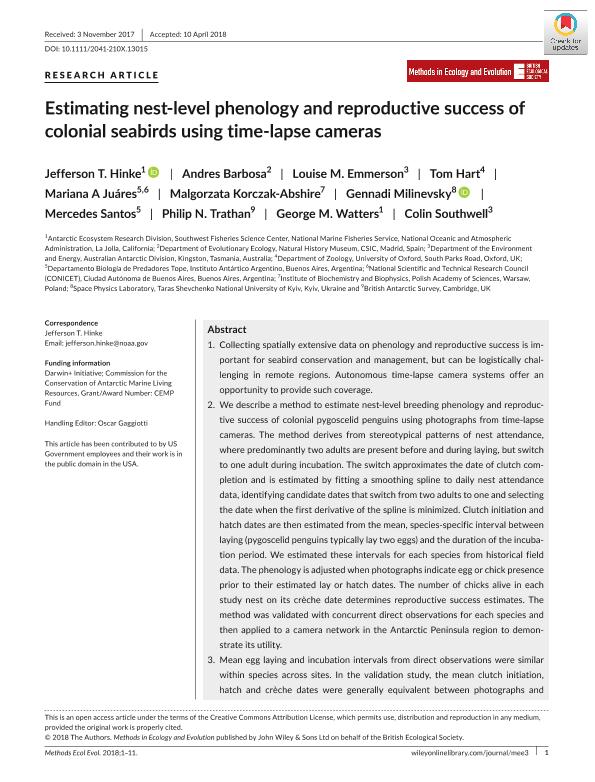Mostrar el registro sencillo del ítem
dc.contributor.author
Hinke, Jefferson T.
dc.contributor.author
Barbosa, Andres
dc.contributor.author
Emmerson, Louise M.
dc.contributor.author
Hart, Tom
dc.contributor.author
Juares, Mariana Alejandra

dc.contributor.author
Korczak Abshire, Malgorzata
dc.contributor.author
Milinevsky, Gennadi
dc.contributor.author
Santos, Maria Mercedes

dc.contributor.author
Trathan, Philip N.
dc.contributor.author
Watters, George M.
dc.contributor.author
Southwell, Colin
dc.date.available
2020-02-26T18:22:52Z
dc.date.issued
2018-08
dc.identifier.citation
Hinke, Jefferson T.; Barbosa, Andres; Emmerson, Louise M.; Hart, Tom; Juares, Mariana Alejandra; et al.; Estimating nest-level phenology and reproductive success of colonial seabirds using time-lapse cameras; Wiley; Methods in Ecology and Evolution; 9; 8; 8-2018; 1853-1863
dc.identifier.issn
2041-210X
dc.identifier.uri
http://hdl.handle.net/11336/98447
dc.description.abstract
Collecting spatially extensive data on phenology and reproductive success is important for seabird conservation and management, but can be logistically challenging in remote regions. Autonomous time-lapse camera systems offer an opportunity to provide such coverage. We describe a method to estimate nest-level breeding phenology and reproductive success of colonial pygoscelid penguins using photographs from time-lapse cameras. The method derives from stereotypical patterns of nest attendance, where predominantly two adults are present before and during laying, but switch to one adult during incubation. The switch approximates the date of clutch completion and is estimated by fitting a smoothing spline to daily nest attendance data, identifying candidate dates that switch from two adults to one and selecting the date when the first derivative of the spline is minimized. Clutch initiation and hatch dates are then estimated from the mean, species-specific interval between laying (pygoscelid penguins typically lay two eggs) and the duration of the incubation period. We estimated these intervals for each species from historical field data. The phenology is adjusted when photographs indicate egg or chick presence prior to their estimated lay or hatch dates. The number of chicks alive in each study nest on its crèche date determines reproductive success estimates. The method was validated with concurrent direct observations for each species and then applied to a camera network in the Antarctic Peninsula region to demonstrate its utility. Mean egg laying and incubation intervals from direct observations were similar within species across sites. In the validation study, the mean clutch initiation, hatch and crèche dates were generally equivalent between photographs and direct observations. Estimates of reproductive success were identical. Applying the method to a time-lapse network suggested relatively high reproductive success for all species across the region and corroborated general understanding of latitudinal trends and species-level plasticity in phenology. The method accurately estimated phenology and reproductive success relative to direct observations and appears well-suited to operationalize regional time-lapse camera networks. The estimation method should be applicable for other seabirds with stereotypical nest attendance patterns from which breeding phenology could be estimated.
dc.format
application/pdf
dc.language.iso
eng
dc.publisher
Wiley

dc.rights
info:eu-repo/semantics/openAccess
dc.rights.uri
https://creativecommons.org/licenses/by/2.5/ar/
dc.subject
ANTARCTICA
dc.subject
CAMERA
dc.subject
MONITORING
dc.subject
PENGUIN
dc.subject
PHENOLOGY
dc.subject
REPRODUCTIVE SUCCESS
dc.subject
SEABIRD
dc.subject
TIME-LAPSE
dc.subject.classification
Zoología, Ornitología, Entomología, Etología

dc.subject.classification
Ciencias Biológicas

dc.subject.classification
CIENCIAS NATURALES Y EXACTAS

dc.title
Estimating nest-level phenology and reproductive success of colonial seabirds using time-lapse cameras
dc.type
info:eu-repo/semantics/article
dc.type
info:ar-repo/semantics/artículo
dc.type
info:eu-repo/semantics/publishedVersion
dc.date.updated
2019-12-20T22:52:20Z
dc.journal.volume
9
dc.journal.number
8
dc.journal.pagination
1853-1863
dc.journal.pais
Reino Unido

dc.description.fil
Fil: Hinke, Jefferson T.. National Marine Fisheries Service; Estados Unidos. National Ocean And Atmospheric Administration; Estados Unidos
dc.description.fil
Fil: Barbosa, Andres. Consejo Superior de Investigaciones Científicas. Museo Nacional de Ciencias Naturales; España
dc.description.fil
Fil: Emmerson, Louise M.. Australian Antarctic Division; Australia
dc.description.fil
Fil: Hart, Tom. University of Oxford; Reino Unido
dc.description.fil
Fil: Juares, Mariana Alejandra. Consejo Nacional de Investigaciones Científicas y Técnicas; Argentina. Ministerio de Relaciones Exteriores, Comercio Interno y Culto. Dirección Nacional del Antártico. Instituto Antártico Argentino; Argentina
dc.description.fil
Fil: Korczak Abshire, Malgorzata. Polish Academy of Sciences; Argentina
dc.description.fil
Fil: Milinevsky, Gennadi. Taras Shevchenko National University of Kyiv; Ucrania
dc.description.fil
Fil: Santos, Maria Mercedes. Ministerio de Relaciones Exteriores, Comercio Interno y Culto. Dirección Nacional del Antártico. Instituto Antártico Argentino; Argentina. Consejo Nacional de Investigaciones Científicas y Técnicas; Argentina
dc.description.fil
Fil: Trathan, Philip N.. British Antartic Survey; Reino Unido
dc.description.fil
Fil: Watters, George M.. National Marine Fisheries Service; Estados Unidos. National Ocean And Atmospheric Administration; Estados Unidos
dc.description.fil
Fil: Southwell, Colin. Australian Antarctic Division; Australia
dc.journal.title
Methods in Ecology and Evolution
dc.relation.alternativeid
info:eu-repo/semantics/altIdentifier/doi/http://dx.doi.org/10.1111/2041-210X.13015
dc.relation.alternativeid
info:eu-repo/semantics/altIdentifier/url/https://besjournals.onlinelibrary.wiley.com/doi/full/10.1111/2041-210X.13015
Archivos asociados
